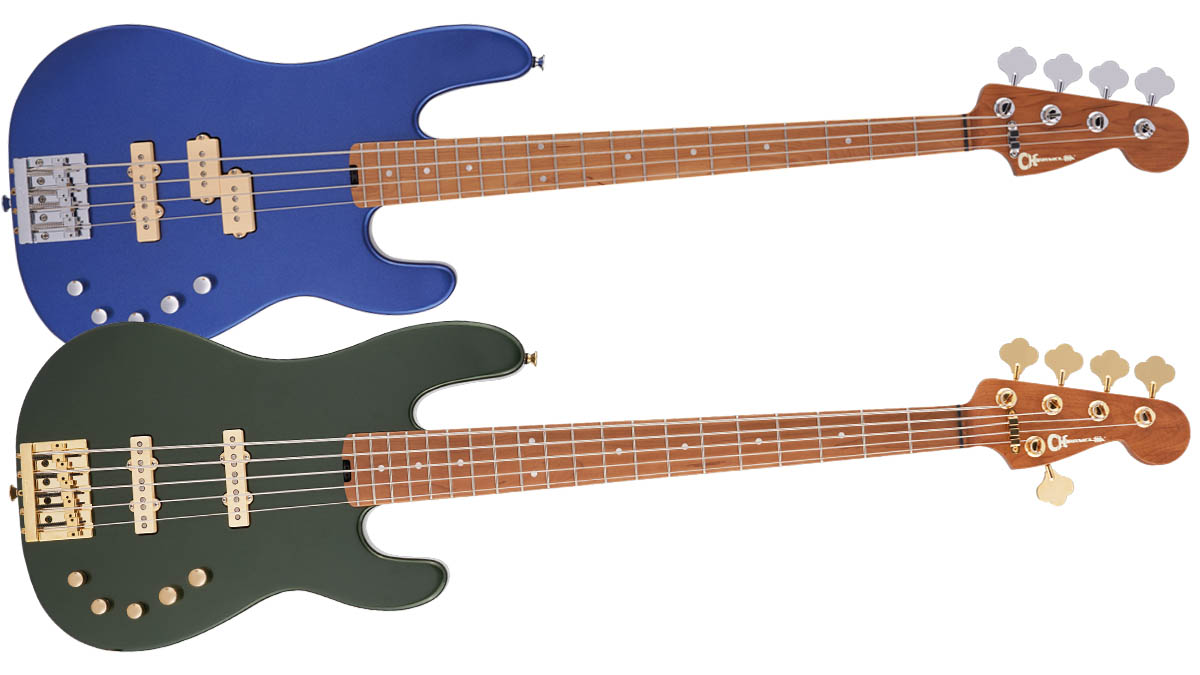Guitar World Verdict
Not just an exercise in nostalgia, the Charvel Pro-Mod San Dimas PJ IV and JJ V basses remain absolutely relevant in the 21st century, with a playability that will flatter players of all abilities.
Pros
- +
Comfortable body.
- +
Great EQ.
- +
Insanely playable neck.
Cons
- -
Pickups don’t sound very different.
You can trust Guitar World
Without diving completely into a nostalgic Stranger Things and Ready Player One rabbithole, let’s just say that these vivid, almost day-glo basses from the most '80s bass brand of them all, Charvel, take us instantly back four decades.
That is, let’s be honest, a huge part of their attraction, just as it was for all those lime-green BC Rich and Jackson basses that infested MTV back then.
Presumably Fender – Charvel’s owners since 2002 – are aware that nostalgia doesn’t necessarily equate to quality, which is why their designers have loaded these relatively affordable basses with player-friendly features.
Still, the very name ‘San Dimas’ is utterly Bill & Ted, right? And the ‘Pro-Mod’ designation – which apparently means ‘hot-rodded’ – is pure skateboard half-pipe. Let’s plug and play, dudes... I mean, readers.
Build Quality
For a reasonable but not particularly excessive chunk of your taxed income, you get an active, bolt-on bass with either four (PJ IV) or five (JJ V) strings. Both are fairly lightweight, with an abdomen-friendly body chamfer for the ‘well-nourished’ bassist, and two graphite reinforcement rods running through the necks.
The active EQ, presumably where the Pro-Mod branding earns its stripes, comes in the form of the expected three-band cut and boost, and a pickup blend and master volume complete the control layout.
The pickups are DiMarzios, like the original '80s San Dimas basses, for an extra touch of authenticity. As always, the fine details are where mid-market basses tend to fall down, but there’s none of that on our review models, which have been set up with a super-low action.

Each has one of those handy pop-out battery compartments, which will be made mandatory on all active basses after the revolution; a heel-mounted truss rod adjustment wheel for that genuine 1987 touch; and a solid, high-mass bridge.
The fretboard edges are rolled, the fret ends buffed, the control pots and tuners rotate smoothly, and there are Luminlay side dots on the neck to save you when the stage lights go off in the middle of your solo in Sweet Child O’Mine. I’ve seen it happen...
Sounds and Playability
It’s interesting that Charvel describe the pickup on either bass nearest the neck as the ‘middle’ one. It’s accurate to label it that way – rather than as the ‘neck’ pickup – but it instantly begs the question of why they didn’t move it forward a bit.
This would have increased the difference in tone between it and the bridge unit, a difference which is not huge, as things stand. There’s definitely a bit more edge from the rear pickup, make no mistake, but the comparison is not huge. As Lemmy, himself a pretty '80s character, once barked at me over a glass of something noxious, “I like ’em to sound different, not the same, like they do on Fenders!”
As it happens, you can tweak the pickup blend all you like, but the real tone range comes from the supercharged active EQ. Fully boosted, the top end is useful rather than scintillating, but that’s fine – these are Fender-alike basses, after all. The bottom end is much more potent, kicking out a floor-shaking rumble if you max it out.

Fortunately the three tone controls have center detentes, which I know I always go on about, but they do come in rather useful when you’re trying to tame a boost as powerful as this.
Playability is these instruments’ middle name, so to speak. This is largely to do with the ‘speed neck’, as Charvel somewhat amusingly name it, a truly slippery shredder’s delight.
The familiar 12” to 16” compound radius (see this month’s column by Dr R. Elrick for more on this very subject) has been enhanced with a practically frictionless finish and a very fl at heel for those foot-on-monitor, mullet-blown-by-fan moments. On the JJ V, with its 35” scale and correspondingly taut low B-string, this amount of shreddiness is especially welcome.

Conclusions
No arguments from me: I love these basses. For me at least, they take away everything that I like least about traditional Fenders – the chunky bodies, the predictable tones, the sticky necks – and give you an instrument that is somehow both '80s and modern at the same time.
That’s quite a feat at this price point, and whether the retro vibes amuse or annoy you, if you’re looking for a souped-up Fender variant, you should really give one of these a whirl.
Specs
- PRICE: $899 / £849 ($999 / £929)
- MADE IN: Mexico
- BODY: Alder
- NECK: Caramelized maple, reinforced with graphite rods, 34” scale (35” scale)
- NECK JOIN: Bolt-on
- FRETBOARD: Caramelized maple, 20 frets, GraphTech nut
- PICKUPS: DiMarzio Model P DP122 (middle), Model J DP123 (bridge) (Area J DP550
- [middle], Area J DP551 [bridge])
- CONTROLS: Volume, pickup blend, three-band active EQ
- HARDWARE: Charvel chrome (gold) tuners and hi-mass bridge
- WEIGHT: 8 lbs (8.5 lbs)
- LEFT-HANDED OPTION AVAILABLE: No
- CASE/GIG-BAG INCLUDED: No
- CONTACT: Charvel
Joel McIver was the Editor of Bass Player magazine from 2018 to 2022, having spent six years before that editing Bass Guitar magazine. A journalist with 25 years' experience in the music field, he's also the author of 35 books, a couple of bestsellers among them. He regularly appears on podcasts, radio and TV.
“It holds its own purely as a playable guitar. It’s really cool for the traveling musician – you can bring it on a flight and it fits beneath the seat”: Why Steve Stevens put his name to a foldable guitar
“Finely tuned instruments with effortless playability and one of the best vibratos there is”: PRS Standard 24 Satin and S2 Standard 24 Satin review












